Construction Management Report: Melbourne Tall Building Construction
VerifiedAdded on 2023/06/10
|23
|5133
|80
Report
AI Summary
This comprehensive report delves into the intricacies of construction management, specifically focusing on the structural analysis of tall buildings. It explores critical concepts such as structural forces, design principles, and various foundation systems, including pile foundations. The report further examines excavation techniques, ground stabilization methods, and dewatering techniques essential for basement construction. Additionally, it covers common structural systems, materials, construction methods like slip form and tunnel form, and the plant and machinery utilized in tall building projects. The report emphasizes the importance of safe work practices and adherence to relevant codes and standards, providing a detailed overview of the construction process from structural design to demolition. The methodology involves a thorough exploration of the topics, supported by diagrams and figures, to illustrate key concepts and principles within the field of construction management. The report meets the learning outcomes of structural analysis, foundation systems, excavation techniques, and construction methods.

Construction Management 1
Report On
Construction Management
By Student’s Name
Course Name
Professor’s Name
University Name
City, State
Date
Report On
Construction Management
By Student’s Name
Course Name
Professor’s Name
University Name
City, State
Date
Paraphrase This Document
Need a fresh take? Get an instant paraphrase of this document with our AI Paraphraser
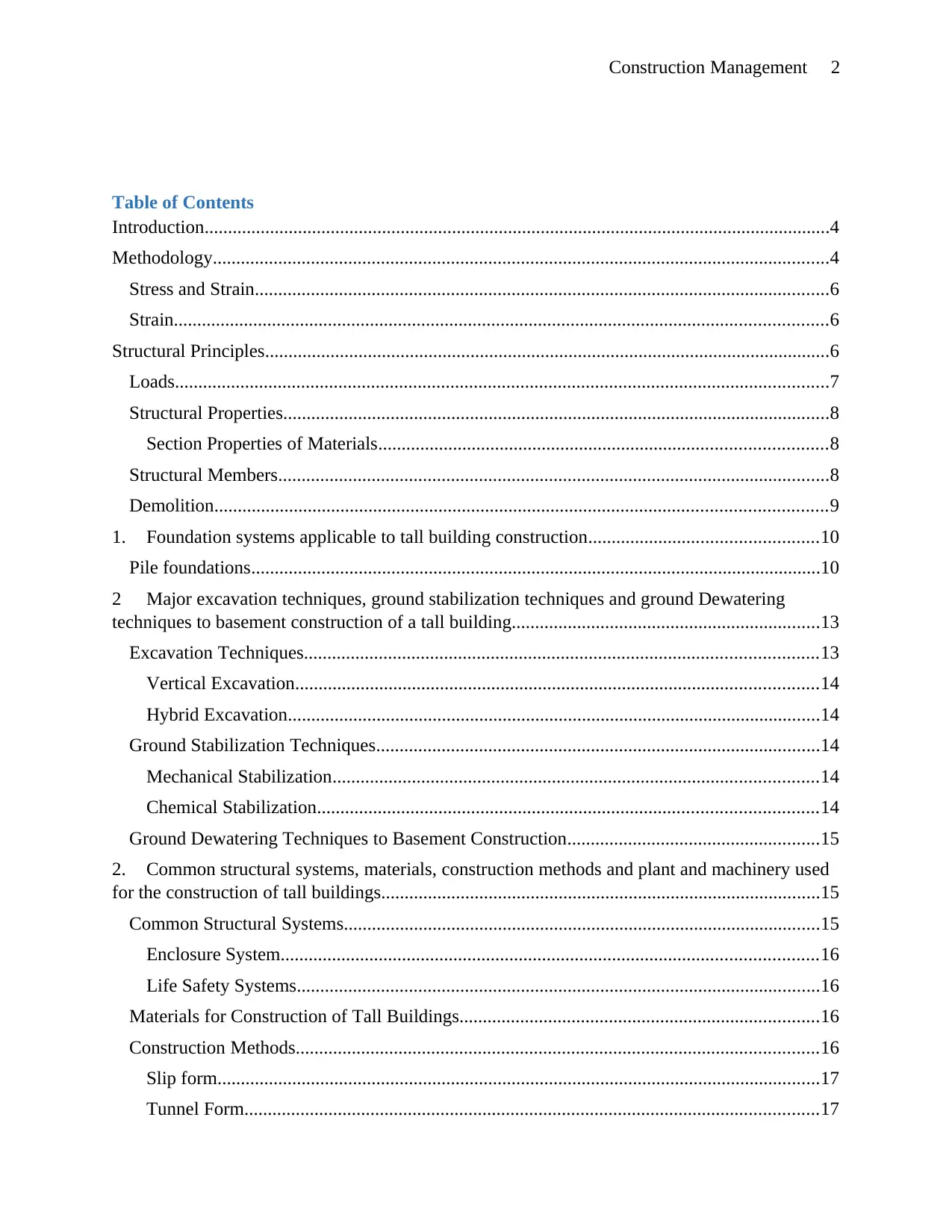
Construction Management 2
Table of Contents
Introduction......................................................................................................................................4
Methodology....................................................................................................................................4
Stress and Strain...........................................................................................................................6
Strain............................................................................................................................................6
Structural Principles.........................................................................................................................6
Loads............................................................................................................................................7
Structural Properties.....................................................................................................................8
Section Properties of Materials................................................................................................8
Structural Members......................................................................................................................8
Demolition...................................................................................................................................9
1. Foundation systems applicable to tall building construction.................................................10
Pile foundations..........................................................................................................................10
2 Major excavation techniques, ground stabilization techniques and ground Dewatering
techniques to basement construction of a tall building..................................................................13
Excavation Techniques..............................................................................................................13
Vertical Excavation................................................................................................................14
Hybrid Excavation..................................................................................................................14
Ground Stabilization Techniques...............................................................................................14
Mechanical Stabilization........................................................................................................14
Chemical Stabilization...........................................................................................................14
Ground Dewatering Techniques to Basement Construction......................................................15
2. Common structural systems, materials, construction methods and plant and machinery used
for the construction of tall buildings..............................................................................................15
Common Structural Systems......................................................................................................15
Enclosure System...................................................................................................................16
Life Safety Systems................................................................................................................16
Materials for Construction of Tall Buildings.............................................................................16
Construction Methods................................................................................................................16
Slip form.................................................................................................................................17
Tunnel Form...........................................................................................................................17
Table of Contents
Introduction......................................................................................................................................4
Methodology....................................................................................................................................4
Stress and Strain...........................................................................................................................6
Strain............................................................................................................................................6
Structural Principles.........................................................................................................................6
Loads............................................................................................................................................7
Structural Properties.....................................................................................................................8
Section Properties of Materials................................................................................................8
Structural Members......................................................................................................................8
Demolition...................................................................................................................................9
1. Foundation systems applicable to tall building construction.................................................10
Pile foundations..........................................................................................................................10
2 Major excavation techniques, ground stabilization techniques and ground Dewatering
techniques to basement construction of a tall building..................................................................13
Excavation Techniques..............................................................................................................13
Vertical Excavation................................................................................................................14
Hybrid Excavation..................................................................................................................14
Ground Stabilization Techniques...............................................................................................14
Mechanical Stabilization........................................................................................................14
Chemical Stabilization...........................................................................................................14
Ground Dewatering Techniques to Basement Construction......................................................15
2. Common structural systems, materials, construction methods and plant and machinery used
for the construction of tall buildings..............................................................................................15
Common Structural Systems......................................................................................................15
Enclosure System...................................................................................................................16
Life Safety Systems................................................................................................................16
Materials for Construction of Tall Buildings.............................................................................16
Construction Methods................................................................................................................16
Slip form.................................................................................................................................17
Tunnel Form...........................................................................................................................17
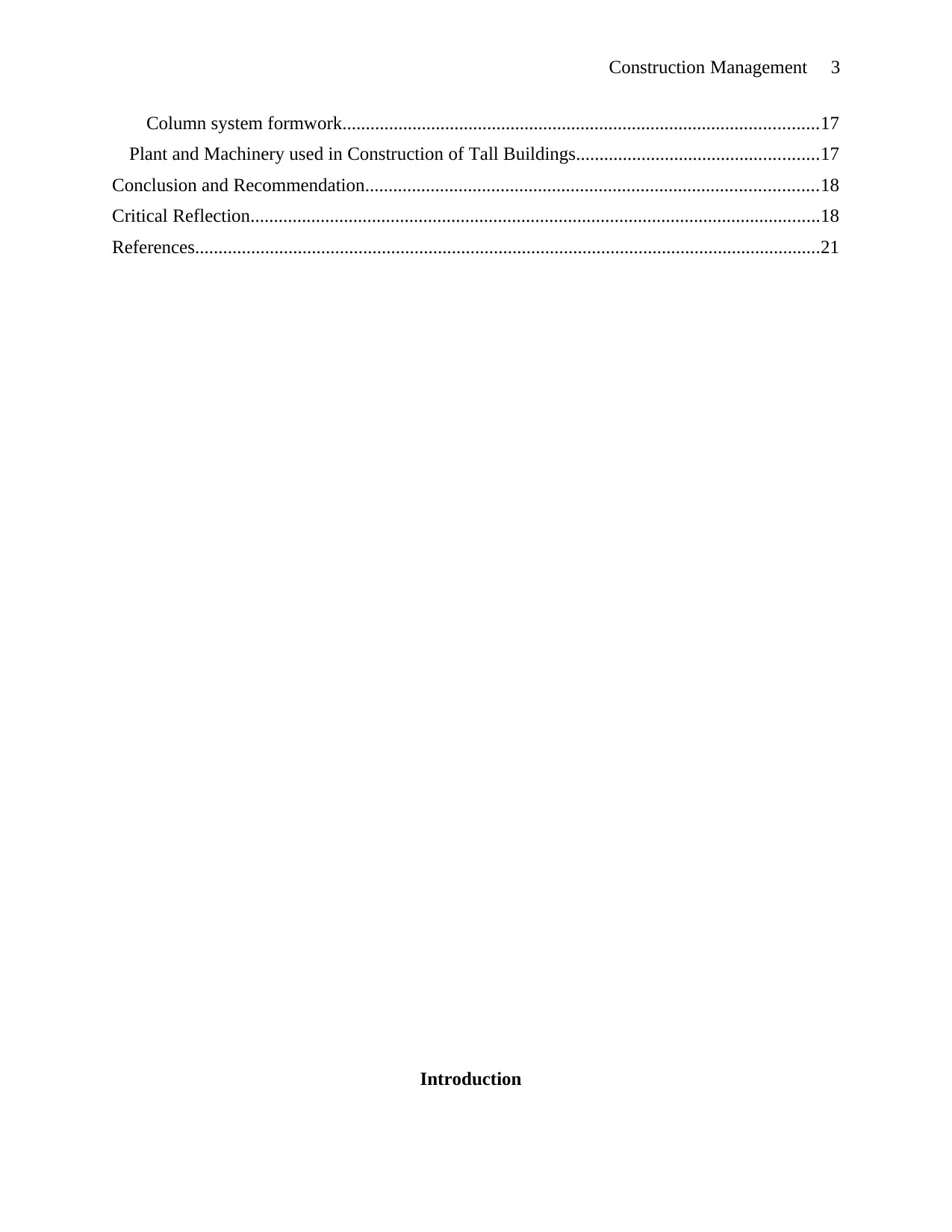
Construction Management 3
Column system formwork......................................................................................................17
Plant and Machinery used in Construction of Tall Buildings....................................................17
Conclusion and Recommendation.................................................................................................18
Critical Reflection..........................................................................................................................18
References......................................................................................................................................21
Introduction
Column system formwork......................................................................................................17
Plant and Machinery used in Construction of Tall Buildings....................................................17
Conclusion and Recommendation.................................................................................................18
Critical Reflection..........................................................................................................................18
References......................................................................................................................................21
Introduction
⊘ This is a preview!⊘
Do you want full access?
Subscribe today to unlock all pages.

Trusted by 1+ million students worldwide
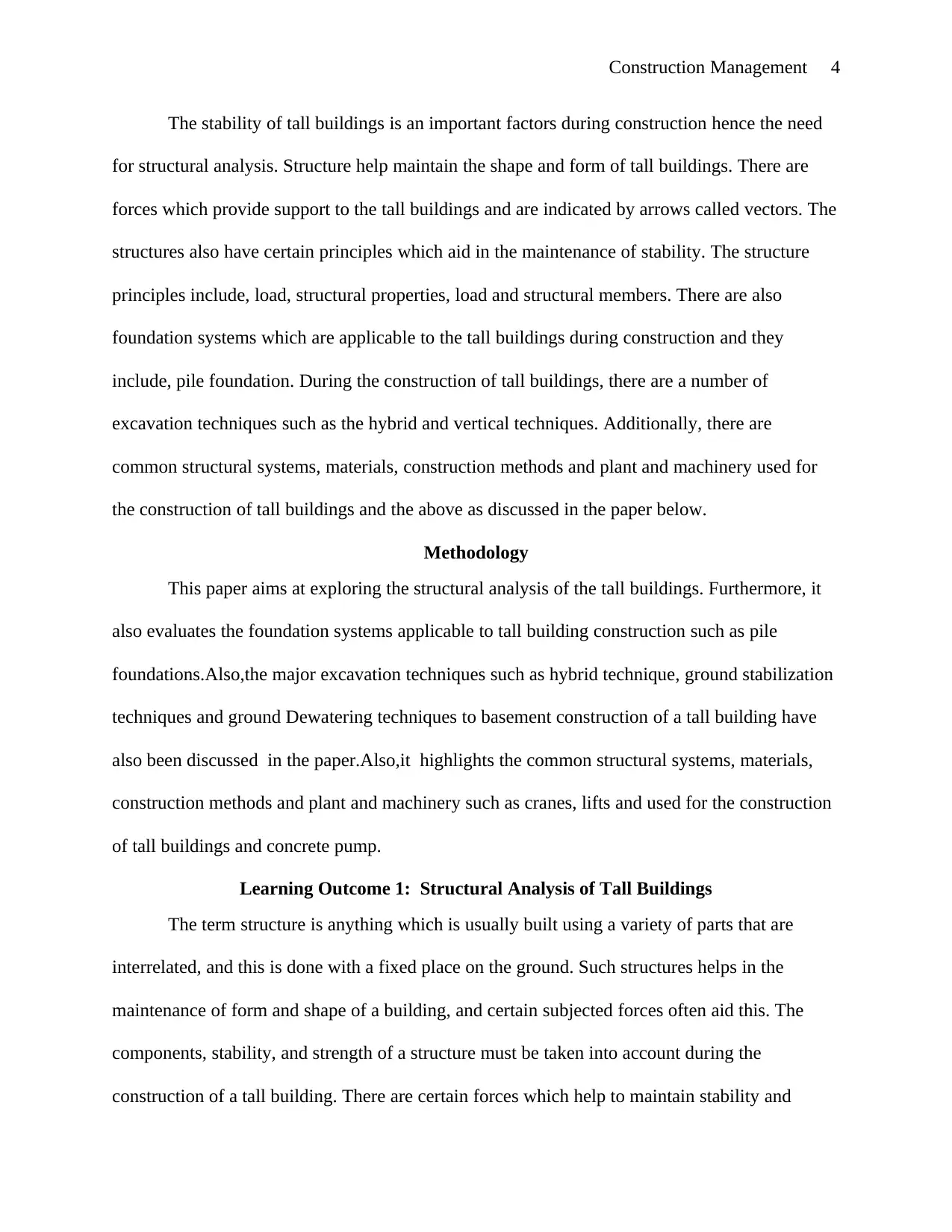
Construction Management 4
The stability of tall buildings is an important factors during construction hence the need
for structural analysis. Structure help maintain the shape and form of tall buildings. There are
forces which provide support to the tall buildings and are indicated by arrows called vectors. The
structures also have certain principles which aid in the maintenance of stability. The structure
principles include, load, structural properties, load and structural members. There are also
foundation systems which are applicable to the tall buildings during construction and they
include, pile foundation. During the construction of tall buildings, there are a number of
excavation techniques such as the hybrid and vertical techniques. Additionally, there are
common structural systems, materials, construction methods and plant and machinery used for
the construction of tall buildings and the above as discussed in the paper below.
Methodology
This paper aims at exploring the structural analysis of the tall buildings. Furthermore, it
also evaluates the foundation systems applicable to tall building construction such as pile
foundations.Also,the major excavation techniques such as hybrid technique, ground stabilization
techniques and ground Dewatering techniques to basement construction of a tall building have
also been discussed in the paper.Also,it highlights the common structural systems, materials,
construction methods and plant and machinery such as cranes, lifts and used for the construction
of tall buildings and concrete pump.
Learning Outcome 1: Structural Analysis of Tall Buildings
The term structure is anything which is usually built using a variety of parts that are
interrelated, and this is done with a fixed place on the ground. Such structures helps in the
maintenance of form and shape of a building, and certain subjected forces often aid this. The
components, stability, and strength of a structure must be taken into account during the
construction of a tall building. There are certain forces which help to maintain stability and
The stability of tall buildings is an important factors during construction hence the need
for structural analysis. Structure help maintain the shape and form of tall buildings. There are
forces which provide support to the tall buildings and are indicated by arrows called vectors. The
structures also have certain principles which aid in the maintenance of stability. The structure
principles include, load, structural properties, load and structural members. There are also
foundation systems which are applicable to the tall buildings during construction and they
include, pile foundation. During the construction of tall buildings, there are a number of
excavation techniques such as the hybrid and vertical techniques. Additionally, there are
common structural systems, materials, construction methods and plant and machinery used for
the construction of tall buildings and the above as discussed in the paper below.
Methodology
This paper aims at exploring the structural analysis of the tall buildings. Furthermore, it
also evaluates the foundation systems applicable to tall building construction such as pile
foundations.Also,the major excavation techniques such as hybrid technique, ground stabilization
techniques and ground Dewatering techniques to basement construction of a tall building have
also been discussed in the paper.Also,it highlights the common structural systems, materials,
construction methods and plant and machinery such as cranes, lifts and used for the construction
of tall buildings and concrete pump.
Learning Outcome 1: Structural Analysis of Tall Buildings
The term structure is anything which is usually built using a variety of parts that are
interrelated, and this is done with a fixed place on the ground. Such structures helps in the
maintenance of form and shape of a building, and certain subjected forces often aid this. The
components, stability, and strength of a structure must be taken into account during the
construction of a tall building. There are certain forces which help to maintain stability and
Paraphrase This Document
Need a fresh take? Get an instant paraphrase of this document with our AI Paraphraser
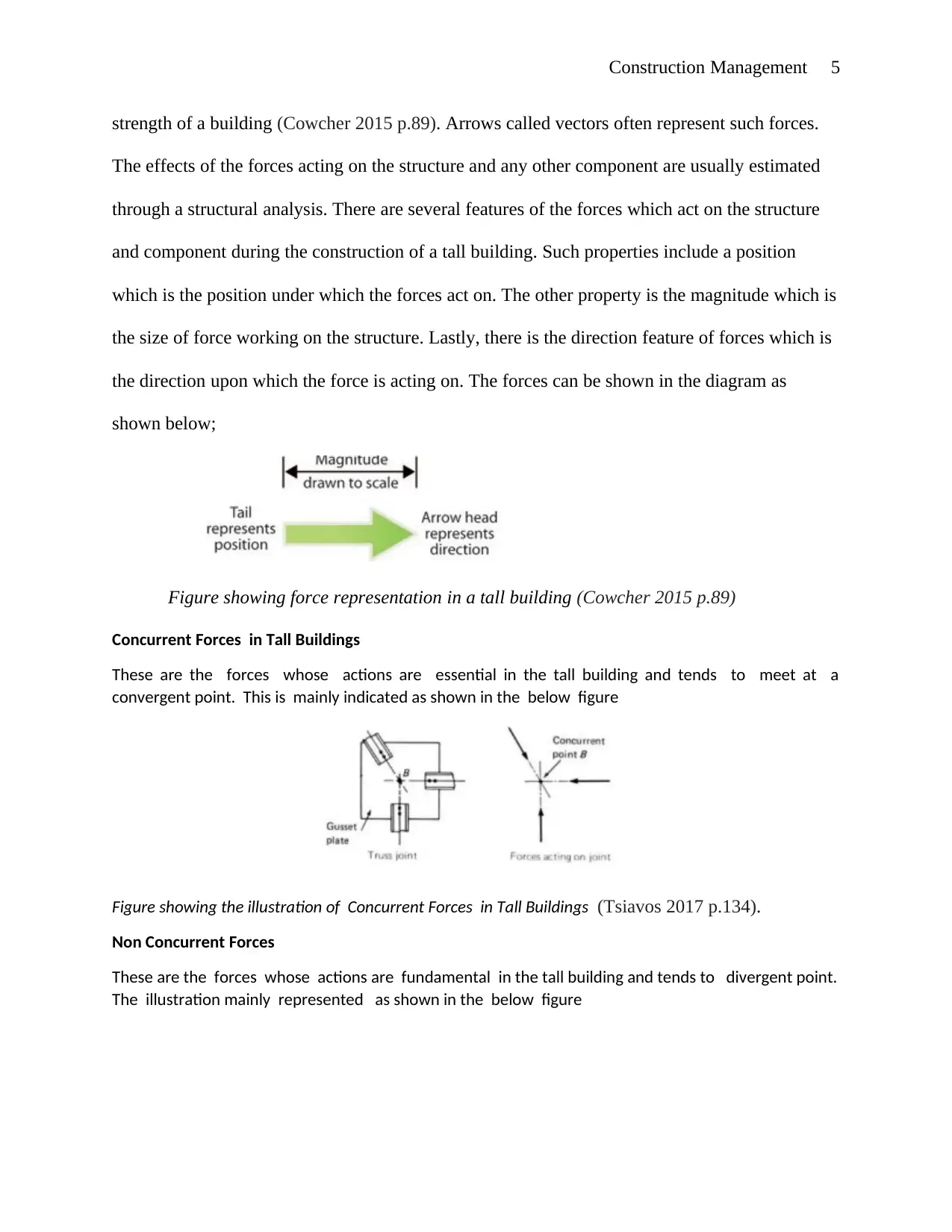
Construction Management 5
strength of a building (Cowcher 2015 p.89). Arrows called vectors often represent such forces.
The effects of the forces acting on the structure and any other component are usually estimated
through a structural analysis. There are several features of the forces which act on the structure
and component during the construction of a tall building. Such properties include a position
which is the position under which the forces act on. The other property is the magnitude which is
the size of force working on the structure. Lastly, there is the direction feature of forces which is
the direction upon which the force is acting on. The forces can be shown in the diagram as
shown below;
Figure showing force representation in a tall building (Cowcher 2015 p.89)
Concurrent Forces in Tall Buildings
These are the forces whose actions are essential in the tall building and tends to meet at a
convergent point. This is mainly indicated as shown in the below figure
Figure showing the illustration of Concurrent Forces in Tall Buildings (Tsiavos 2017 p.134).
Non Concurrent Forces
These are the forces whose actions are fundamental in the tall building and tends to divergent point.
The illustration mainly represented as shown in the below figure
strength of a building (Cowcher 2015 p.89). Arrows called vectors often represent such forces.
The effects of the forces acting on the structure and any other component are usually estimated
through a structural analysis. There are several features of the forces which act on the structure
and component during the construction of a tall building. Such properties include a position
which is the position under which the forces act on. The other property is the magnitude which is
the size of force working on the structure. Lastly, there is the direction feature of forces which is
the direction upon which the force is acting on. The forces can be shown in the diagram as
shown below;
Figure showing force representation in a tall building (Cowcher 2015 p.89)
Concurrent Forces in Tall Buildings
These are the forces whose actions are essential in the tall building and tends to meet at a
convergent point. This is mainly indicated as shown in the below figure
Figure showing the illustration of Concurrent Forces in Tall Buildings (Tsiavos 2017 p.134).
Non Concurrent Forces
These are the forces whose actions are fundamental in the tall building and tends to divergent point.
The illustration mainly represented as shown in the below figure
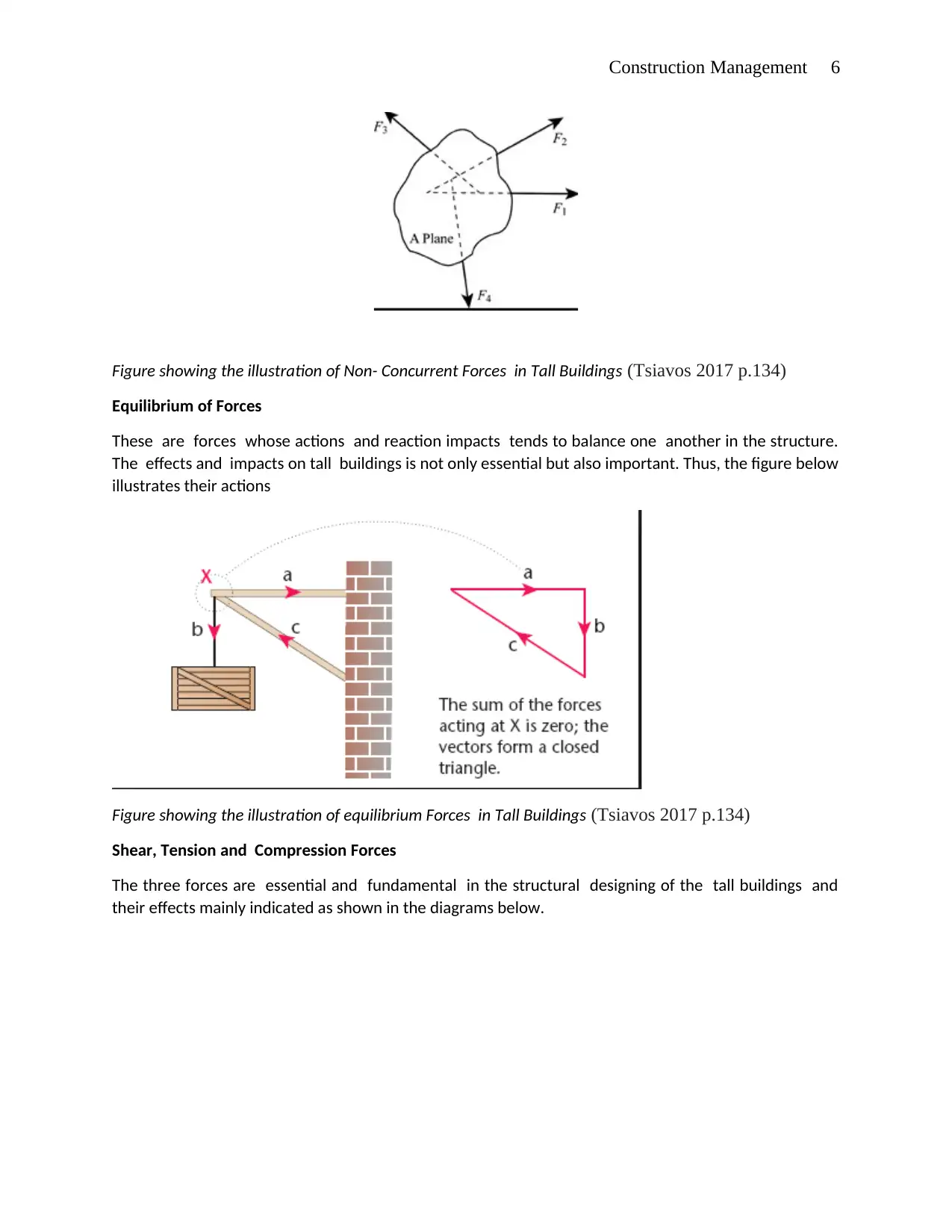
Construction Management 6
Figure showing the illustration of Non- Concurrent Forces in Tall Buildings (Tsiavos 2017 p.134)
Equilibrium of Forces
These are forces whose actions and reaction impacts tends to balance one another in the structure.
The effects and impacts on tall buildings is not only essential but also important. Thus, the figure below
illustrates their actions
Figure showing the illustration of equilibrium Forces in Tall Buildings (Tsiavos 2017 p.134)
Shear, Tension and Compression Forces
The three forces are essential and fundamental in the structural designing of the tall buildings and
their effects mainly indicated as shown in the diagrams below.
Figure showing the illustration of Non- Concurrent Forces in Tall Buildings (Tsiavos 2017 p.134)
Equilibrium of Forces
These are forces whose actions and reaction impacts tends to balance one another in the structure.
The effects and impacts on tall buildings is not only essential but also important. Thus, the figure below
illustrates their actions
Figure showing the illustration of equilibrium Forces in Tall Buildings (Tsiavos 2017 p.134)
Shear, Tension and Compression Forces
The three forces are essential and fundamental in the structural designing of the tall buildings and
their effects mainly indicated as shown in the diagrams below.
⊘ This is a preview!⊘
Do you want full access?
Subscribe today to unlock all pages.

Trusted by 1+ million students worldwide
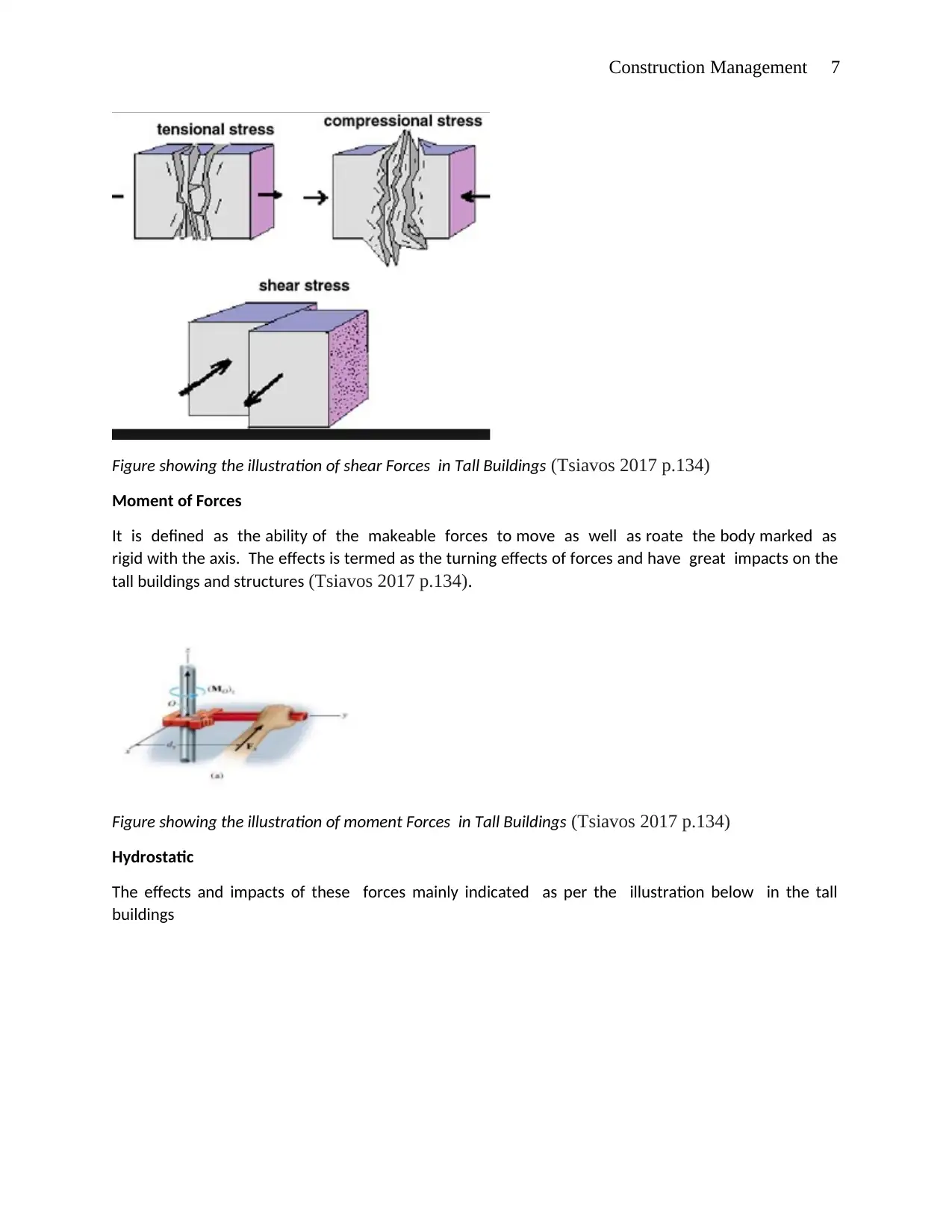
Construction Management 7
Figure showing the illustration of shear Forces in Tall Buildings (Tsiavos 2017 p.134)
Moment of Forces
It is defined as the ability of the makeable forces to move as well as roate the body marked as
rigid with the axis. The effects is termed as the turning effects of forces and have great impacts on the
tall buildings and structures (Tsiavos 2017 p.134).
Figure showing the illustration of moment Forces in Tall Buildings (Tsiavos 2017 p.134)
Hydrostatic
The effects and impacts of these forces mainly indicated as per the illustration below in the tall
buildings
Figure showing the illustration of shear Forces in Tall Buildings (Tsiavos 2017 p.134)
Moment of Forces
It is defined as the ability of the makeable forces to move as well as roate the body marked as
rigid with the axis. The effects is termed as the turning effects of forces and have great impacts on the
tall buildings and structures (Tsiavos 2017 p.134).
Figure showing the illustration of moment Forces in Tall Buildings (Tsiavos 2017 p.134)
Hydrostatic
The effects and impacts of these forces mainly indicated as per the illustration below in the tall
buildings
Paraphrase This Document
Need a fresh take? Get an instant paraphrase of this document with our AI Paraphraser
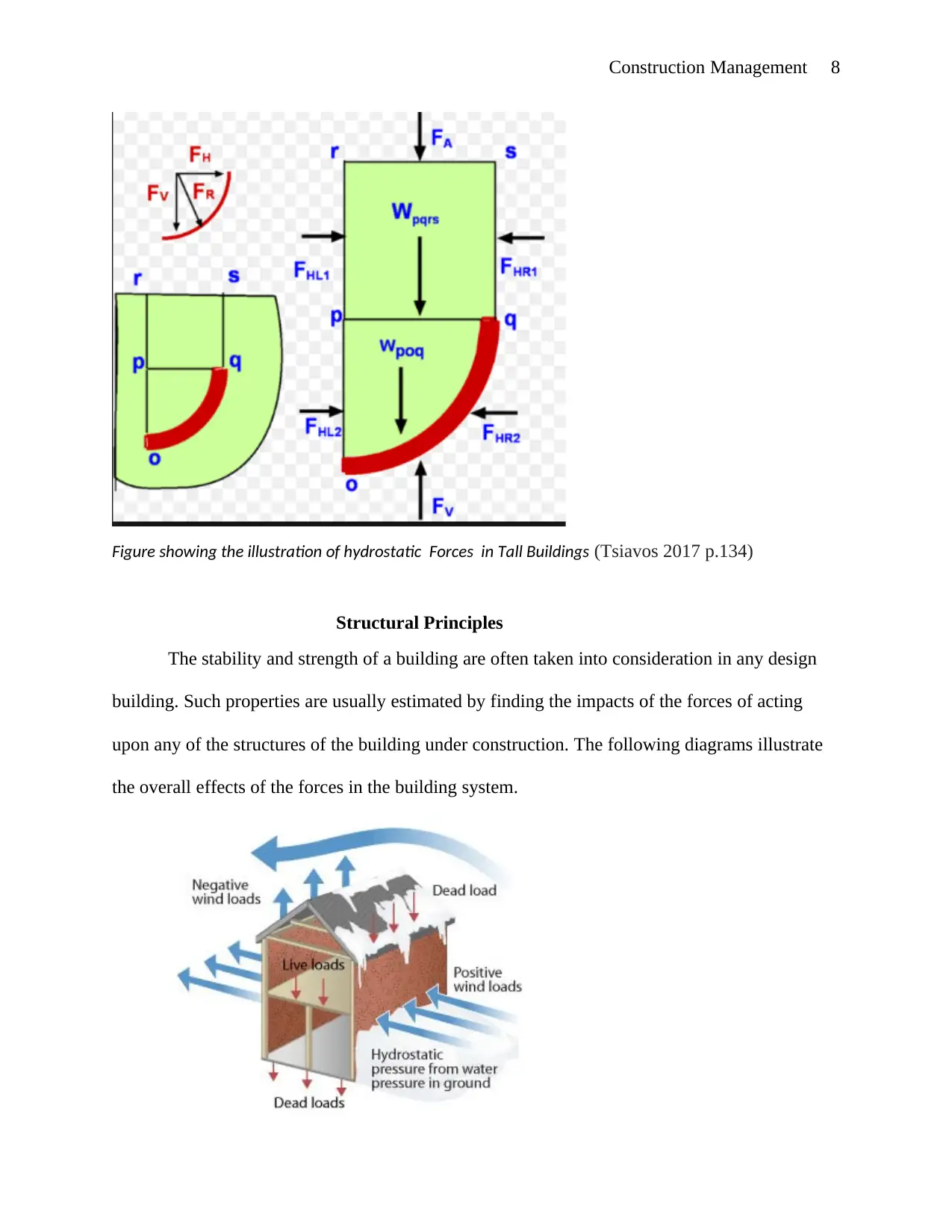
Construction Management 8
Figure showing the illustration of hydrostatic Forces in Tall Buildings (Tsiavos 2017 p.134)
Structural Principles
The stability and strength of a building are often taken into consideration in any design
building. Such properties are usually estimated by finding the impacts of the forces of acting
upon any of the structures of the building under construction. The following diagrams illustrate
the overall effects of the forces in the building system.
Figure showing the illustration of hydrostatic Forces in Tall Buildings (Tsiavos 2017 p.134)
Structural Principles
The stability and strength of a building are often taken into consideration in any design
building. Such properties are usually estimated by finding the impacts of the forces of acting
upon any of the structures of the building under construction. The following diagrams illustrate
the overall effects of the forces in the building system.
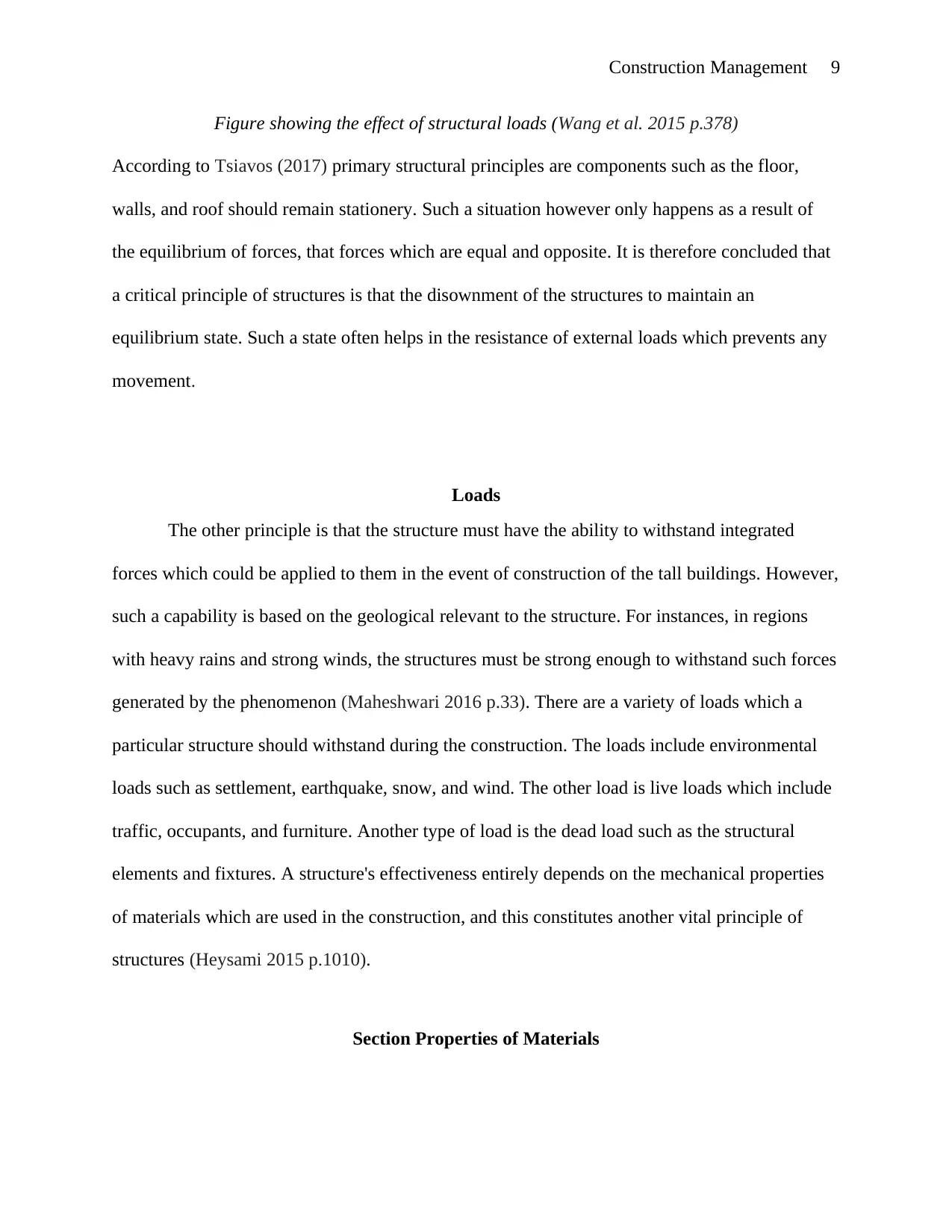
Construction Management 9
Figure showing the effect of structural loads (Wang et al. 2015 p.378)
According to Tsiavos (2017) primary structural principles are components such as the floor,
walls, and roof should remain stationery. Such a situation however only happens as a result of
the equilibrium of forces, that forces which are equal and opposite. It is therefore concluded that
a critical principle of structures is that the disownment of the structures to maintain an
equilibrium state. Such a state often helps in the resistance of external loads which prevents any
movement.
Loads
The other principle is that the structure must have the ability to withstand integrated
forces which could be applied to them in the event of construction of the tall buildings. However,
such a capability is based on the geological relevant to the structure. For instances, in regions
with heavy rains and strong winds, the structures must be strong enough to withstand such forces
generated by the phenomenon (Maheshwari 2016 p.33). There are a variety of loads which a
particular structure should withstand during the construction. The loads include environmental
loads such as settlement, earthquake, snow, and wind. The other load is live loads which include
traffic, occupants, and furniture. Another type of load is the dead load such as the structural
elements and fixtures. A structure's effectiveness entirely depends on the mechanical properties
of materials which are used in the construction, and this constitutes another vital principle of
structures (Heysami 2015 p.1010).
Section Properties of Materials
Figure showing the effect of structural loads (Wang et al. 2015 p.378)
According to Tsiavos (2017) primary structural principles are components such as the floor,
walls, and roof should remain stationery. Such a situation however only happens as a result of
the equilibrium of forces, that forces which are equal and opposite. It is therefore concluded that
a critical principle of structures is that the disownment of the structures to maintain an
equilibrium state. Such a state often helps in the resistance of external loads which prevents any
movement.
Loads
The other principle is that the structure must have the ability to withstand integrated
forces which could be applied to them in the event of construction of the tall buildings. However,
such a capability is based on the geological relevant to the structure. For instances, in regions
with heavy rains and strong winds, the structures must be strong enough to withstand such forces
generated by the phenomenon (Maheshwari 2016 p.33). There are a variety of loads which a
particular structure should withstand during the construction. The loads include environmental
loads such as settlement, earthquake, snow, and wind. The other load is live loads which include
traffic, occupants, and furniture. Another type of load is the dead load such as the structural
elements and fixtures. A structure's effectiveness entirely depends on the mechanical properties
of materials which are used in the construction, and this constitutes another vital principle of
structures (Heysami 2015 p.1010).
Section Properties of Materials
⊘ This is a preview!⊘
Do you want full access?
Subscribe today to unlock all pages.

Trusted by 1+ million students worldwide
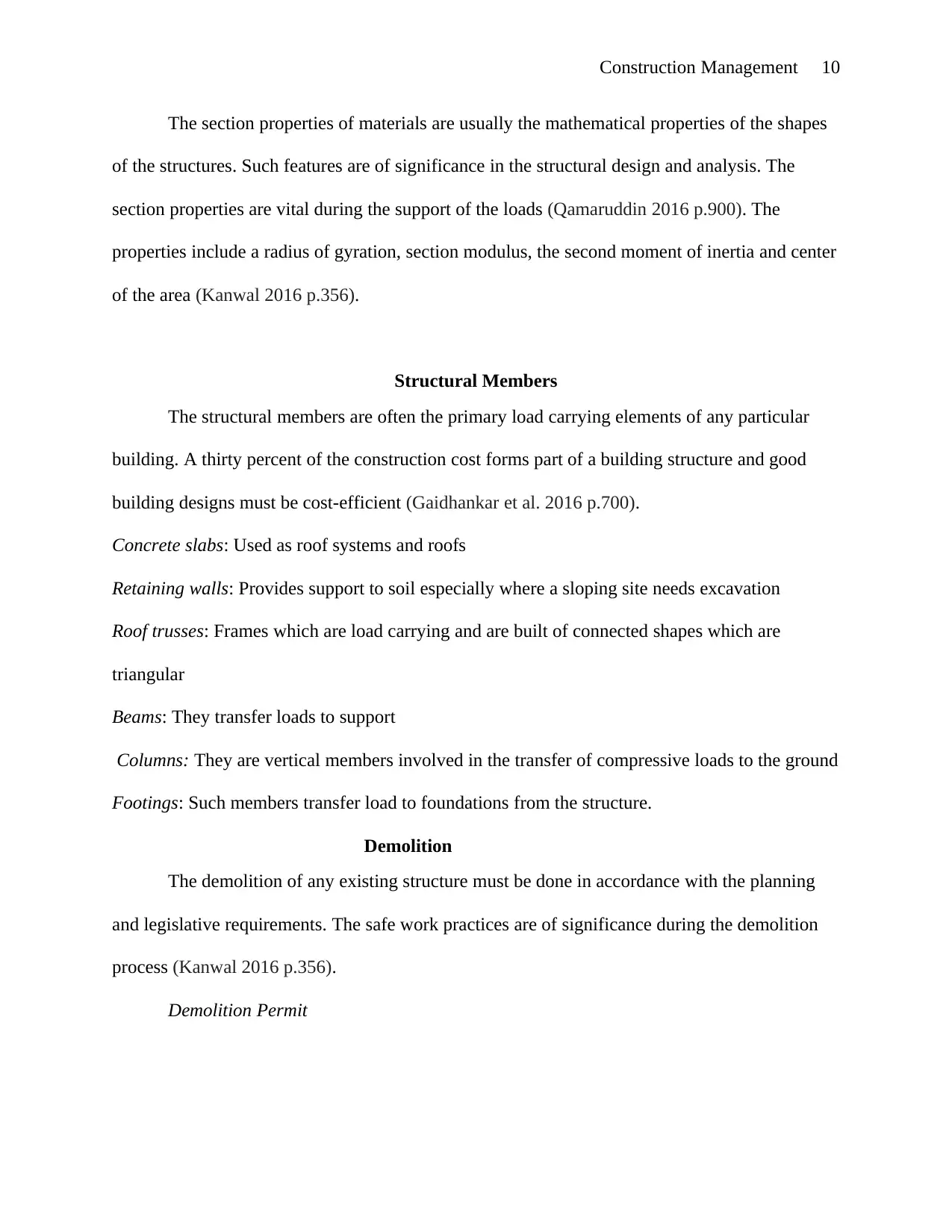
Construction Management 10
The section properties of materials are usually the mathematical properties of the shapes
of the structures. Such features are of significance in the structural design and analysis. The
section properties are vital during the support of the loads (Qamaruddin 2016 p.900). The
properties include a radius of gyration, section modulus, the second moment of inertia and center
of the area (Kanwal 2016 p.356).
Structural Members
The structural members are often the primary load carrying elements of any particular
building. A thirty percent of the construction cost forms part of a building structure and good
building designs must be cost-efficient (Gaidhankar et al. 2016 p.700).
Concrete slabs: Used as roof systems and roofs
Retaining walls: Provides support to soil especially where a sloping site needs excavation
Roof trusses: Frames which are load carrying and are built of connected shapes which are
triangular
Beams: They transfer loads to support
Columns: They are vertical members involved in the transfer of compressive loads to the ground
Footings: Such members transfer load to foundations from the structure.
Demolition
The demolition of any existing structure must be done in accordance with the planning
and legislative requirements. The safe work practices are of significance during the demolition
process (Kanwal 2016 p.356).
Demolition Permit
The section properties of materials are usually the mathematical properties of the shapes
of the structures. Such features are of significance in the structural design and analysis. The
section properties are vital during the support of the loads (Qamaruddin 2016 p.900). The
properties include a radius of gyration, section modulus, the second moment of inertia and center
of the area (Kanwal 2016 p.356).
Structural Members
The structural members are often the primary load carrying elements of any particular
building. A thirty percent of the construction cost forms part of a building structure and good
building designs must be cost-efficient (Gaidhankar et al. 2016 p.700).
Concrete slabs: Used as roof systems and roofs
Retaining walls: Provides support to soil especially where a sloping site needs excavation
Roof trusses: Frames which are load carrying and are built of connected shapes which are
triangular
Beams: They transfer loads to support
Columns: They are vertical members involved in the transfer of compressive loads to the ground
Footings: Such members transfer load to foundations from the structure.
Demolition
The demolition of any existing structure must be done in accordance with the planning
and legislative requirements. The safe work practices are of significance during the demolition
process (Kanwal 2016 p.356).
Demolition Permit
Paraphrase This Document
Need a fresh take? Get an instant paraphrase of this document with our AI Paraphraser
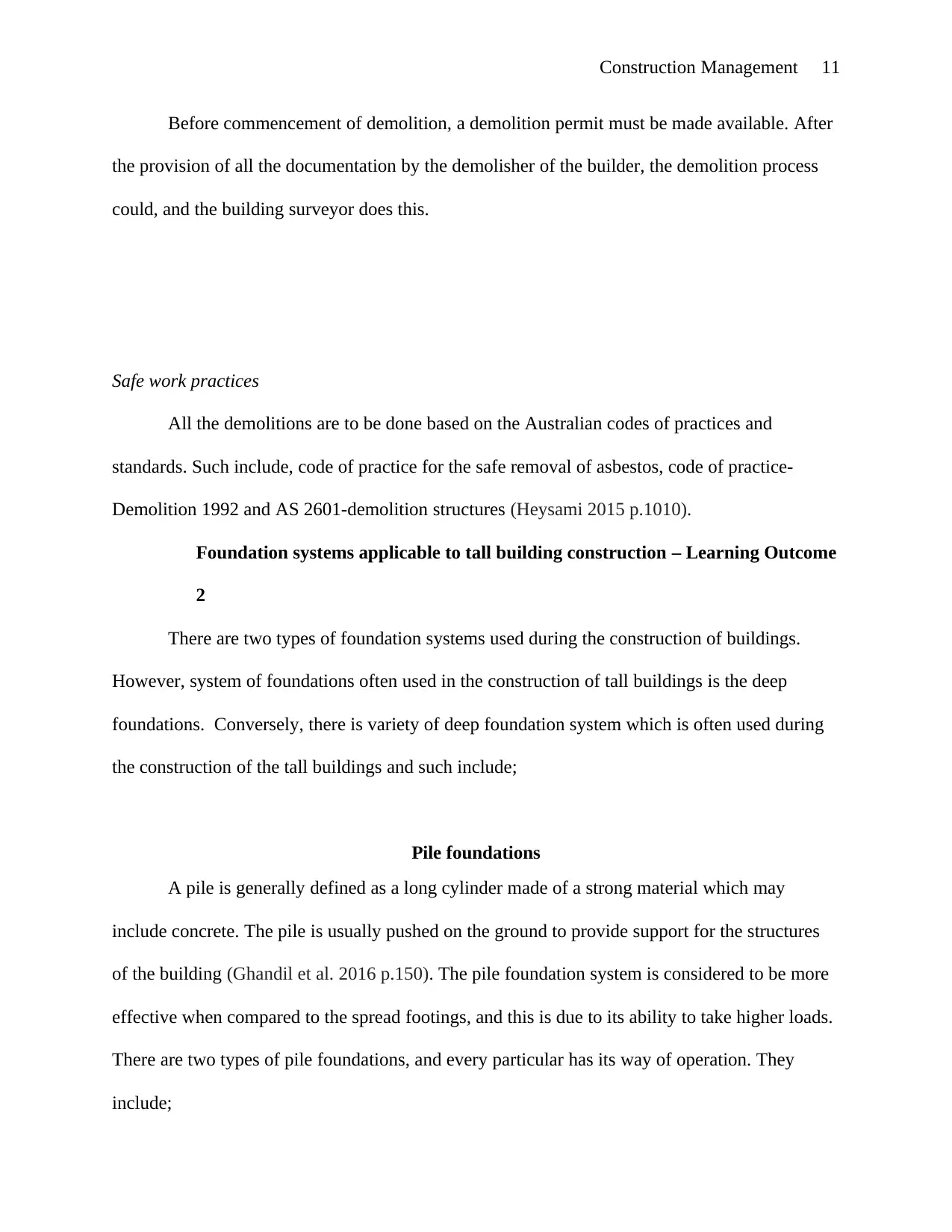
Construction Management 11
Before commencement of demolition, a demolition permit must be made available. After
the provision of all the documentation by the demolisher of the builder, the demolition process
could, and the building surveyor does this.
Safe work practices
All the demolitions are to be done based on the Australian codes of practices and
standards. Such include, code of practice for the safe removal of asbestos, code of practice-
Demolition 1992 and AS 2601-demolition structures (Heysami 2015 p.1010).
Foundation systems applicable to tall building construction – Learning Outcome
2
There are two types of foundation systems used during the construction of buildings.
However, system of foundations often used in the construction of tall buildings is the deep
foundations. Conversely, there is variety of deep foundation system which is often used during
the construction of the tall buildings and such include;
Pile foundations
A pile is generally defined as a long cylinder made of a strong material which may
include concrete. The pile is usually pushed on the ground to provide support for the structures
of the building (Ghandil et al. 2016 p.150). The pile foundation system is considered to be more
effective when compared to the spread footings, and this is due to its ability to take higher loads.
There are two types of pile foundations, and every particular has its way of operation. They
include;
Before commencement of demolition, a demolition permit must be made available. After
the provision of all the documentation by the demolisher of the builder, the demolition process
could, and the building surveyor does this.
Safe work practices
All the demolitions are to be done based on the Australian codes of practices and
standards. Such include, code of practice for the safe removal of asbestos, code of practice-
Demolition 1992 and AS 2601-demolition structures (Heysami 2015 p.1010).
Foundation systems applicable to tall building construction – Learning Outcome
2
There are two types of foundation systems used during the construction of buildings.
However, system of foundations often used in the construction of tall buildings is the deep
foundations. Conversely, there is variety of deep foundation system which is often used during
the construction of the tall buildings and such include;
Pile foundations
A pile is generally defined as a long cylinder made of a strong material which may
include concrete. The pile is usually pushed on the ground to provide support for the structures
of the building (Ghandil et al. 2016 p.150). The pile foundation system is considered to be more
effective when compared to the spread footings, and this is due to its ability to take higher loads.
There are two types of pile foundations, and every particular has its way of operation. They
include;
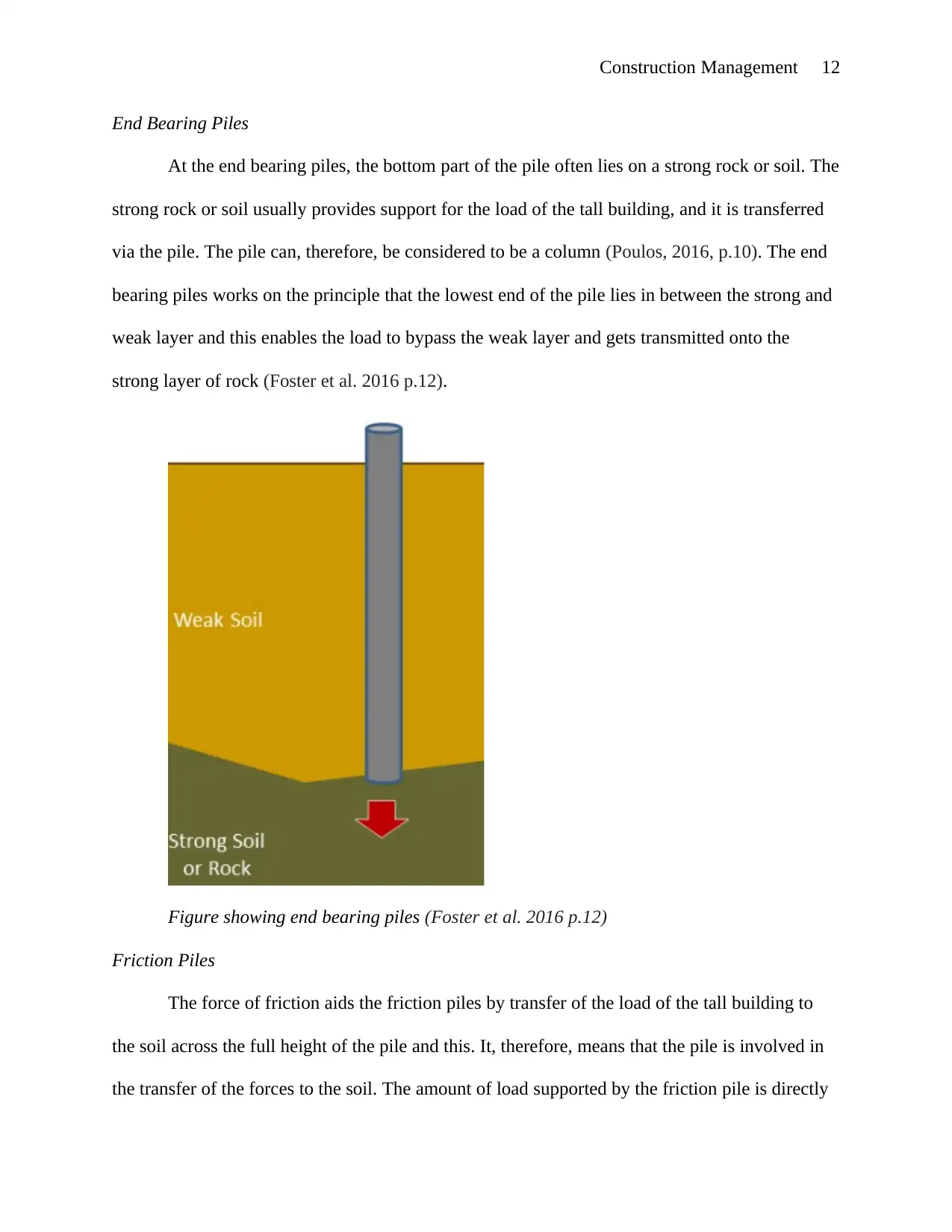
Construction Management 12
End Bearing Piles
At the end bearing piles, the bottom part of the pile often lies on a strong rock or soil. The
strong rock or soil usually provides support for the load of the tall building, and it is transferred
via the pile. The pile can, therefore, be considered to be a column (Poulos, 2016, p.10). The end
bearing piles works on the principle that the lowest end of the pile lies in between the strong and
weak layer and this enables the load to bypass the weak layer and gets transmitted onto the
strong layer of rock (Foster et al. 2016 p.12).
Figure showing end bearing piles (Foster et al. 2016 p.12)
Friction Piles
The force of friction aids the friction piles by transfer of the load of the tall building to
the soil across the full height of the pile and this. It, therefore, means that the pile is involved in
the transfer of the forces to the soil. The amount of load supported by the friction pile is directly
End Bearing Piles
At the end bearing piles, the bottom part of the pile often lies on a strong rock or soil. The
strong rock or soil usually provides support for the load of the tall building, and it is transferred
via the pile. The pile can, therefore, be considered to be a column (Poulos, 2016, p.10). The end
bearing piles works on the principle that the lowest end of the pile lies in between the strong and
weak layer and this enables the load to bypass the weak layer and gets transmitted onto the
strong layer of rock (Foster et al. 2016 p.12).
Figure showing end bearing piles (Foster et al. 2016 p.12)
Friction Piles
The force of friction aids the friction piles by transfer of the load of the tall building to
the soil across the full height of the pile and this. It, therefore, means that the pile is involved in
the transfer of the forces to the soil. The amount of load supported by the friction pile is directly
⊘ This is a preview!⊘
Do you want full access?
Subscribe today to unlock all pages.

Trusted by 1+ million students worldwide
1 out of 23
Related Documents
Your All-in-One AI-Powered Toolkit for Academic Success.
+13062052269
info@desklib.com
Available 24*7 on WhatsApp / Email
![[object Object]](/_next/static/media/star-bottom.7253800d.svg)
Unlock your academic potential
Copyright © 2020–2025 A2Z Services. All Rights Reserved. Developed and managed by ZUCOL.




